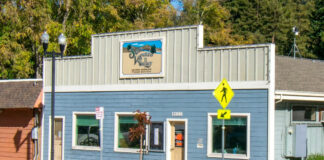Sometimes it seems that every gardener who asks me for advice has the same problem: “What can I do with my narrow planting area?” It might be a fence line that needs something pretty or an area against the house, but whatever problem spot you have there’s a solution for you.
You might be considering a vine on a trellis, and there are many to choose from, but are there other plants that can be trained to grow flat against a wall, supported on a lattice or a framework of stakes. An espaliered plant can be a fruit tree or ornamental tree or shrub. While most any tree or large shrub can be made into an espalier, the trick is to select a species that will ultimately fit your space and conditions. There are many plants you might not have thought about that are easy to train so they don’t take up too much space.
The practice of training fruit bearing plants like fig, apple and pear and citrus dates back to the Roman and Egyptians, but it was the Europeans – specifically the French – who perfected the designs we see today.
Narrow spaces can be challenging. One of my favorite plants that naturally grows flat is grewia occidentals or Lavender Starflower. it grows fast in sun and attracts hummingbirds and other birds. Beautiful lavender flowers cover the plant from spring to fall.
Another plant, azara microphylla, also grows flat without much coaxing on your part. This small dainty tree is fast growing and reaches 15-25 ft tall. The yellow flower clusters will fill your garden with the scent of white chocolate in late winter. They are ideal between structures. I’ve used the variegated version to screen a shower and it’s working great. The chocolate fragrance of this plant is really what makes it a showstopper.
Flowering quince is another old garden staple providing early color. They are easy to care for and nearly indestructible in almost any soil that is well drained and not overly fertile. Once established quince is a very drought tolerant plant and their spiny branches make them an excellent choice for hedges, screening or as a security barrier. There are red, pink, orange and white flowering varieties. The Toyo Nishiki cultivar even has pink, white and solid red flowers all on the same branch.
Another small tree, the Compact Carolina cherry laurel can be espaliered also in a narrow space if needed. It grows 10 feet tall but that may be all you need to screen the neighbor. They are drought tolerant once established, deer resistant and the perfect host for birds, bees and butterflies. The leaves smell like cherries when crushed which gives this plant its common name.
Other ornamental shrubs that make great espaliered plants are abutilon, bougainvillea in frost free areas, callistemon, camellia, dodonaea, feijoa, gingko, sarcococca, viburnum, ribes, rhaphiolepis, pyracantha, pittosporum tobira and osmanthus fragrans. Trees that can be trained include cercis, agonis flexuosa, eriobotrya, and podocarps.
California native plants that can be espaliered are garrya, fremontodendron. Carolina cherry, flowering currant and ceanothus while the branches are young and supple.
Don’t be overwhelmed if an espalier gets out of hand during the season. Just nip the branches back to a leaf node. Use heavy jute to attach the branch to the support wire or stake. After a season the jute will rot away which keeps the branch from being girdled by the restraint.
Jan Nelson is a landscape designer and California certified nursery professional. Jan writes about gardening in the Santa Cruz Mountains. Learn more about Jan’s work at http://jannelsonlandscapedesign.com













